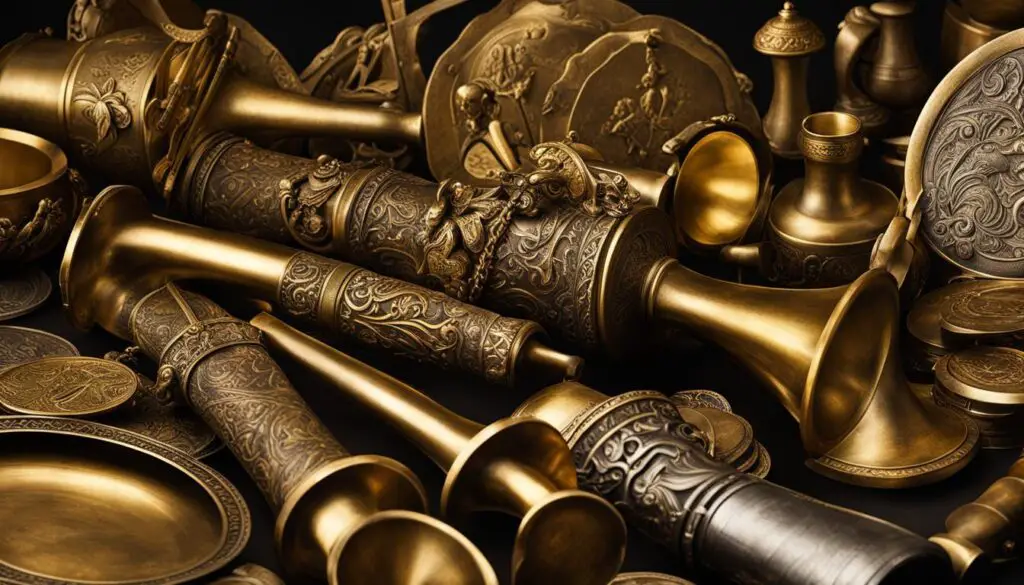Brass, a copper-zinc alloy, holds significant symbolism and historical significance in the Bible. Although not known until the thirteenth century, brass is often used in the Bible to refer to copper. It was utilized for a variety of purposes, including armor, musical instruments, and even currency. Symbolically, brass represents insensibility and obstinacy in sin, as well as strength. The cultural and historical context of brass enhances our understanding of its significance in biblical narratives.
Key Takeaways:
- Brass, an alloy of copper and zinc, is often used in the Bible to refer to copper itself.
- Symbolically, brass represents insensibility and obstinacy in sin, as well as strength.
- The cultural and historical context of brass enhances our understanding of its significance in biblical narratives.
- Brass was used for various purposes such as armor, musical instruments, and currency.
- The term “brass” used in the Bible may inaccurately refer to copper or possibly bronze.
The Use of Brass in the Old Testament
In the Old Testament, the term “brass” is often used to refer to copper or sometimes bronze, an alloy of copper and tin. Brass had various uses in the Bible and played a significant role in religious rituals and construction. One prominent use of brass was in the making of altars, vessels, and other articles for the tabernacle and temple. It was also used for crafting musical instruments such as cymbals and trumpets, as well as armor, bows, fetters, and gates. Brass was even utilized for the creation of idols and mirrors.
The abundance of brass and its versatility made it an essential material in the construction and rituals of the temple. References to the use of brass can be found in specific Bible verses, such as Exodus 38:28, which mentions the brass from the mirrors of the serving women being used for the laver of the tabernacle. 1 Kings 7:14 describes the brass pillars made by Hiram for Solomon’s temple, and Daniel 5:4 mentions the brass vessels used in the feast of Belshazzar.
To provide a more comprehensive understanding of the use of brass in the Old Testament, the table below summarizes the key references and their significance:
| Bible Verses | Significance |
|---|---|
| Exodus 38:28 | Use of brass from mirrors for the tabernacle laver |
| 1 Kings 7:14 | Brass pillars made for Solomon’s temple |
| Daniel 5:4 | Brass vessels used in the feast of Belshazzar |
These references highlight the significant role of brass in the Old Testament and its presence in the construction of religious articles, the tabernacle, and the temple. Brass was a material of choice for its durability and malleability, making it an essential component in the worship and rituals of the ancient Hebrews.
Brass Altar in Exodus 38:1
“And he made the altar of burnt offering of shittim wood: five cubits was the length thereof, and five cubits the breadth thereof; it was foursquare; and three cubits the height thereof. And he made the horns thereof on the four corners of it; the horns thereof were of the same: and he overlaid it with brass.”
– Exodus 38:1
Symbolism of Brass in the Bible
Brass holds significant symbolic meaning in the Bible, representing various concepts and themes. The metaphorical use of brass emphasizes both positive and negative qualities, shedding light on the human condition and spiritual significance. One prominent example is the brazen serpent made by Moses, which symbolizes healing and deliverance from the punishment of snake bites. This powerful symbol later finds connection to Jesus’ crucifixion and the salvation it brings.
“And as Moses lifted up the serpent in the wilderness, even so must the Son of Man be lifted up, that whoever believes in Him should not perish but have eternal life.” – John 3:14-15
In addition to healing and salvation, brass is also metaphorically associated with strength and endurance. Deuteronomy and Micah mention brass in relation to the strength of individuals and nations, highlighting its symbolic representation of power and resilience. Conversely, brass can symbolize insensibility and obstinacy in sin, signifying a hardened heart and resistance to spiritual growth.
The symbolism of brass throughout biblical narratives provides deeper insights into the human condition, spirituality, and the journey of faith for individuals and communities. By understanding the metaphorical use of brass, we can gain a greater appreciation for the layers of meaning embedded within biblical texts.
The Brazen Serpent: A Symbol of Healing and Deliverance
The brazen serpent, as mentioned earlier, is a significant symbol in the Bible. In the book of Numbers, God commands Moses to construct a serpent made of brass and mount it on a pole. Those who were bitten by venomous snakes could look at the serpent and be healed. This act of faith and obedience brought about physical healing and deliverance from the consequences of sin, foreshadowing the ultimate salvation offered through Jesus’ crucifixion.

Brass in the New Testament
Brass continues to be mentioned in the New Testament, primarily in the context of money. In Matthew 10:9, Jesus instructs his disciples not to carry any gold, silver, or brass in their purses. This usage of brass refers to metal currency. During that time, brass coins were commonly used in trade and commerce, alongside other precious metals. The mention of brass in this context highlights its significance as a medium of exchange in biblical times.
While the use of brass in the New Testament is not as extensive as in the Old Testament, it still serves as a reminder of the economic practices and monetary systems of the time. The inclusion of brass in the list of currencies serves to emphasize the practical instructions given to the disciples by Jesus.
“Do not get any gold or silver or copper to take with you in your belts.” – Matthew 10:9 (NIV)
Understanding the use of brass as a form of currency in the New Testament provides valuable insights into the economic landscape of the biblical period. It demonstrates the importance of having a comprehensive understanding of historical and cultural contexts to fully appreciate the significance of biblical references.
| Currency | Value |
|---|---|
| Gold | High value |
| Silver | Medium value |
| Brass | Low value |
Cultural and Historical Context of Brass
In order to understand the significance of brass in the Bible, it is important to consider its cultural and historical context. The term “brass” used in biblical texts may actually refer to copper or possibly bronze, an alloy of copper and tin. The ancient Hebrews likely did not have knowledge of the specific alloy known as brass, which was not discovered until the thirteenth century. Instead, they used the term “brass” to refer to copper or sometimes bronze, both of which were highly valued metals in the ancient world.
Copper and bronze had various uses in ancient societies and held cultural and historical significance. These metals were used for making weapons, tools, and various articles for religious rituals and temple construction. The craftsmanship of working with copper and bronze was highly regarded, and their trade was prevalent, particularly by the Tyrians. The use of these metals, whether referred to as brass or not, played an integral role in shaping the cultural, religious, and economic practices of ancient civilizations.
The term “brass” used in biblical texts may actually refer to copper or possibly bronze, an alloy of copper and tin.
The trade in brass, as understood in the modern sense, likely did not exist in ancient times, as brass as an alloy was not known until much later. However, copper and bronze trade was essential for the exchange of goods and the development of ancient economies. These metals represented wealth, power, and stability, and their availability played a crucial role in the prosperity of nations and the growth of civilizations.
By considering the cultural and historical context of brass, as well as the broader use of copper and bronze in the ancient world, we gain a deeper understanding of the symbolism and significance attributed to these metals in the Bible. These materials were not mere commodities but held immense value and meaning within the religious, social, and economic fabric of ancient societies.

| Religious & Ritual | Construction | Weapons & Armor | Tools & Utensils |
|---|---|---|---|
| Altars | Gates | Swords | Tools |
| Vessels | Columns | Shields | Utensils |
| Idols | Decorative Elements | Bows | Mirrors |
The Brazen Serpent and its Significance
The brazen serpent is a powerful symbol in the Bible, representing healing and deliverance. According to the Book of Numbers in the Old Testament, when the Israelites were plagued by venomous snakes in the wilderness, God instructed Moses to create a serpent out of brass and lift it up on a pole. Those who were bitten by the snakes could look at the brazen serpent and be healed. This miraculous act demonstrated God’s provision of salvation and the importance of faith and obedience.
The brazen serpent holds deep spiritual significance, as it foreshadows the crucifixion of Jesus Christ. In the Gospel of John, Jesus makes a direct reference to the brazen serpent, stating, “And as Moses lifted up the serpent in the wilderness, even so must the Son of Man be lifted up, that whoever believes in Him should not perish but have eternal life.” (John 3:14-15) This connection highlights the parallel between the healing and deliverance provided by looking upon the brazen serpent and the salvation offered through faith in Jesus’ sacrifice on the cross.
“The brazen serpent serves as a tangible reminder of God’s mercy and grace, as well as the need for repentance and trust in His redemptive power.”
The brazen serpent serves as a tangible reminder of God’s mercy and grace, as well as the need for repentance and trust in His redemptive power. It illustrates the concept of substitutionary atonement, where one innocent being takes the place of the guilty, offering healing and salvation. The brazen serpent’s significance extends beyond its historical context and remains a powerful symbol of hope, restoration, and spiritual transformation.

Key Takeaways:
- The brazen serpent, made by Moses, symbolizes healing and deliverance in the Bible.
- Looking at the brazen serpent brought healing to those bitten by venomous snakes.
- Jesus compared Himself to the brazen serpent, emphasizing the importance of faith and His crucifixion for salvation.
- The brazen serpent represents God’s mercy, grace, and the concept of substitutionary atonement.
| Symbol | Meaning |
|---|---|
| Brazen Serpent | Healing and Deliverance |
| Faith and Obedience | The act of looking upon the serpent required faith and obedience in God’s instruction. |
| Connection to Jesus | The brazen serpent foreshadows Jesus’ crucifixion and the salvation offered through faith in Him. |
| Repentance and Redemption | The brazen serpent serves as a reminder of the need for repentance and trust in God’s redemptive power. |
Symbolic Meanings of Brass in Biblical Metaphors
In the Bible, brass is often used metaphorically to convey deep symbolic meanings. This versatile metal represents various concepts and qualities, adding layers of significance to biblical narratives. Let’s explore some of the metaphorical uses of brass and the symbolism associated with it.
Strength and Durability
One of the key symbolic meanings of brass is strength and durability. Just as brass is known for its resilience and ability to withstand pressure, it represents the unwavering strength of individuals or nations. In biblical metaphors, the mention of “gates of brass” or “hoofs of brass” signifies a formidable opponent or an unyielding force that cannot be easily overcome.
Hardness and Obstinance
Brass also carries the metaphorical connotation of hardness and obstinance. It symbolizes the rebellious and unyielding nature of individuals who refuse to heed divine guidance and persist in their sinful ways. The biblical texts often employ brass as a metaphor to describe the insensibility in sin, emphasizing the need for repentance and transformation.
“But they obeyed not, neither inclined their ear, but made their neck stiff, that they might not hear, nor receive instruction.” – Jeremiah 17:23
Endurance and Perseverance
Additionally, brass represents endurance and perseverance in the face of challenges. The metal’s ability to withstand the test of time mirrors the steadfastness required to navigate life’s trials and tribulations. Biblical metaphors that utilize brass highlight the enduring qualities of individuals or situations, emphasizing the importance of resilience and faith in overcoming obstacles.
By employing brass as a metaphorical symbol, the biblical writers evoke powerful imagery and convey profound messages about human nature, divine providence, and the spiritual journey. The use of brass in these metaphors deepens our understanding of the human condition and provides insights into the intricate tapestry of biblical narratives.
| Symbolic Meaning | Biblical Reference |
|---|---|
| Strength and Durability | “His legs are pillars of marble, set upon sockets of fine gold: his countenance is as Lebanon, excellent as the cedars. His mouth is most sweet: yea, he is altogether lovely. This is my beloved, and this is my friend, O daughters of Jerusalem.” – Song of Solomon 5:15-16 |
| Hardness and Obstinance | “But they obeyed not, neither inclined their ear, but made their neck stiff, that they might not hear, nor receive instruction.” – Jeremiah 17:23 |
| Endurance and Perseverance | “And ye shall be hated of all men for my name’s sake: but he that endureth to the end shall be saved.” – Matthew 10:22 |

References to Brass with Symbolic Significance in the Bible
Throughout the Bible, there are several references to brass that carry symbolic significance. These references highlight the use of brass as a metaphor to convey deeper meanings and convey important messages. Let’s explore some of these references:
The Gates and Hoofs of Brass
“Your gates shall be open continually; day and night they shall not be shut, that people may bring to you the wealth of the nations, with their kings led in procession.” – Isaiah 60:11
“I have likened the daughter of Zion to a comely and delicate woman.” – Jeremiah 6:2
In these verses, the gates and hoofs of brass are used metaphorically to represent strength and durability. They symbolize the unwavering resilience and unyielding stance of the people of Zion, emphasizing their ability to withstand challenges and protect their heritage.
The Kingdom of Brass
“And the fourth kingdom shall be strong as iron: forasmuch as iron breaketh in pieces and subdueth all things: and as iron that breaketh all these, shall it break in pieces and bruise.” – Daniel 2:40
Here, the kingdom of brass is described as the fourth kingdom, symbolizing its warlike nature and power. This metaphorical use of brass signifies the strength and dominance of the kingdom, highlighting its ability to conquer and subdue.
The Significance of these References
These references to brass with symbolic significance in the Bible serve as powerful literary devices to convey deeper meanings and messages. They invite readers to delve into the layers of interpretation and reflect on the timeless truths presented within the text.
| Reference | Symbolic Significance |
|---|---|
| Isaiah 60:11 | Strength and durability |
| Jeremiah 6:2 | Unyielding resilience |
| Daniel 2:40 | Warlike nature and power |
These references to brass with symbolic significance in the Bible offer valuable insights into the enduring qualities and characteristics represented by this metal. They remind us of the strength, resilience, and power that can be embodied by individuals, nations, and religious faith.

Brass in the Temple and Worship
Brass instruments played a significant role in temple worship, adding a grand and majestic element to religious ceremonies. The resonating sound of these instruments created an atmosphere of awe and reverence, enhancing the worship experience for the congregation. These instruments were skillfully crafted and meticulously maintained, reflecting the importance placed on music in ancient Hebrew culture.
The significance of brass instruments in temple worship is evident through various biblical references. In 1 Chronicles 15:16, it is mentioned that the brass cymbals were played during the procession of the Ark of God, accompanied by other musical instruments. The book of Psalms also emphasizes the use of trumpets and horns made of brass in praising and worshiping God. Music was an integral part of temple rituals, and the use of brass instruments symbolized the devotion and adoration of the worshipers.
“Praise him with trumpet sound; praise him with lute and harp! Praise him with tambourine and dance; praise him with strings and pipe! Praise him with sounding cymbals; praise him with loud clashing cymbals!” – Psalm 150:3-5
These passages highlight the importance of brass instruments in temple worship and the role they played in uniting the congregation in praise and adoration. The powerful and melodic sounds produced by these instruments added a sense of awe and reverence, creating a sacred atmosphere in which the worshipers could connect with the divine.
| Brass Instruments Used in Temple Worship | Significance |
|---|---|
| Trumpets | Used to announce important events and call the people to worship |
| Cymbals | Produced a loud and resonating sound, symbolizing the exaltation and praise of God |
| Horns | Used to signal the beginning and end of rituals, symbolizing God’s presence and power |
| Shofar | A ram’s horn used for special occasions such as the Feast of Trumpets, symbolizing repentance and spiritual awakening |
The use of brass instruments in temple worship not only added a musical element but also served as a visual representation of the devotion and reverence of the worshipers. The skillful craftsmanship of these instruments and the precise coordination required to play them demonstrated the dedication and discipline of the musicians. The resonance of the brass instruments filled the temple with harmonious melodies, creating an atmosphere conducive to worship and spiritual reflection.
The Transition from Brass to Bronze
As we explore the significance of brass in the Bible, it is important to understand the transition from brass to bronze. The term “brass” used in biblical texts may not always be accurate, as it often refers to copper or possibly bronze. Bronze, an alloy of copper and tin, is likely the correct translation in some instances. This transition from brass to bronze marked a notable advancement in metallurgy during ancient times.
Unlike brass, which is an alloy of copper and zinc, bronze is a stronger and more durable alloy made from copper and tin. The addition of tin to copper enhanced its hardness and resistance to corrosion. This made bronze the preferred material for various implements and weapons, often replacing brass due to its improved qualities. The transition from brass to bronze brought about significant changes in the production and use of metal objects and tools.
The switch from brass to bronze had far-reaching effects in various aspects of society. Bronze was utilized for the creation of weapons, tools, and intricate works of art. It revolutionized the manufacturing process, resulting in more intricate and finely crafted items. The transition also impacted trade and commerce, as the demand for bronze increased, creating new economic opportunities and driving cultural and technological advancements.
Table: Comparing Brass and Bronze
| Property | Brass | Bronze |
|---|---|---|
| Composition | Primarily copper and zinc | Primarily copper and tin |
| Strength | Less strong and malleable | Stronger and more durable |
| Corrosion Resistance | Prone to tarnish and corrosion | Greater resistance to tarnish and corrosion |
| Uses | Musical instruments, currency, armor | Weapons, tools, sculptures |
| Impact | Transitioned to bronze for enhanced strength and durability | Revolutionized manufacturing and trade |
Table: Comparison between brass and bronze, highlighting the differences in composition, strength, corrosion resistance, uses, and impact.
Conclusion
Brass in the Bible holds deep symbolism and significance, reflecting the cultural and historical context of biblical narratives. This alloy, often used to refer to copper, represents strength, endurance, and insensibility in sin. The brazen serpent, crafted by Moses, serves as a powerful symbol of healing and deliverance, providing salvation and the importance of faith.
Within the temple, brass played a vital role in worship, with its use in creating musical instruments like cymbals and trumpets adding grandeur and majesty to religious ceremonies. The craftsmanship and sound quality of brass instruments enhanced the worshippers’ spiritual experience.
Understanding the historical and cultural context enriches our interpretation of the Bible’s symbolic and metaphorical use of brass. It allows us to grasp the immense significance of brass within biblical narratives and appreciate the enduring qualities it represents throughout the Old and New Testaments.
FAQ
What does brass represent in the Bible?
Brass represents insensibility and obstinacy in sin, as well as strength.
How was brass used in the Old Testament?
Brass was used to make altars, vessels, musical instruments, armor, bows, fetters, gates, idols, and mirrors. It was also used for currency.
What is the symbolic significance of the brazen serpent?
The brazen serpent, made by Moses, symbolized healing and deliverance from the punishment of snake bites. Jesus alluded to it in John, linking it to his own crucifixion and salvation.
How is brass referenced in the New Testament?
In the New Testament, brass is mentioned in the context of money. For example, Jesus instructs his disciples in Matthew to not take any gold, silver, or brass in their purses.
What was the cultural and historical context of brass?
Brass, or the alloy of copper and zinc, was likely not known to the ancient Hebrews. The term “brass” used in the Bible often refers to copper or possibly bronze, a compound of copper and tin.
What is the significance of the brazen serpent?
The brazen serpent, made by Moses at God’s command, served as a means of healing and deliverance for the Israelites. It represents God’s provision for salvation and the importance of faith and obedience.
How is brass used metaphorically in the Bible?
Brass can represent hardness, obstinacy, and insensibility in sin. It is also used to symbolize the strength of individuals or nations, highlighting enduring qualities or characteristics.
Are there specific Bible verses that mention brass with symbolic significance?
Yes, references to brass with symbolic significance can be found in verses such as Psalms, Isaiah, Jeremiah, and Daniel.
What was the role of brass in temple worship?
Brass was used to make various musical instruments, such as cymbals and trumpets, which were used in praise and worship. It added grandeur and majesty to religious ceremonies.
How did the transition from brass to bronze occur?
The term “brass” used in the Bible often refers to copper or bronze. Bronze, an alloy of copper and tin, is likely the correct translation in some instances. Bronze became the preferred material for implements and weapons due to its improved strength and durability.







